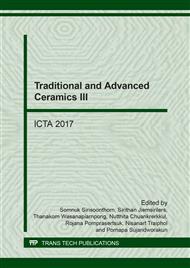p.111
p.117
p.122
p.127
p.133
p.139
p.145
p.151
p.157
Comparison of the Properties of Glasses Made from Two Different Bottom Ashes
Abstract:
Bottom ash is a waste byproduct generated from the combustion or incineration of materials such as coal and household waste. It is a mixed oxide powder of variable composition, though typically high in silica. As a low-cost, readily available material, it has found applications primarily in construction for use as backfill. As a silica-rich, mixed oxide powder though, it may also have glass forming ability. This research studied the possibility to use domestically produced bottom ash powder in glass making. Two bottom ash powders were used, one from a waste incinerator (Phuket) and the other from a coal-fired electric plant (Mae Moh Power Plant, Lampang). The bottom ash was milled into a fine powder and melted within the temperature range of 1300-1500 oC, for 2 hours. The melts were cast in a brass mold and then annealed at 500 oC for 2 hours. It was found that both bottom ashes could successfully produce glasses. The Vickers hardness, refractive index and specific gravity of the glasses will be discussed.
Info:
Periodical:
Pages:
133-138
Citation:
Online since:
April 2018
Keywords:
Price:
Сopyright:
© 2018 Trans Tech Publications Ltd. All Rights Reserved
Share:
Citation:


